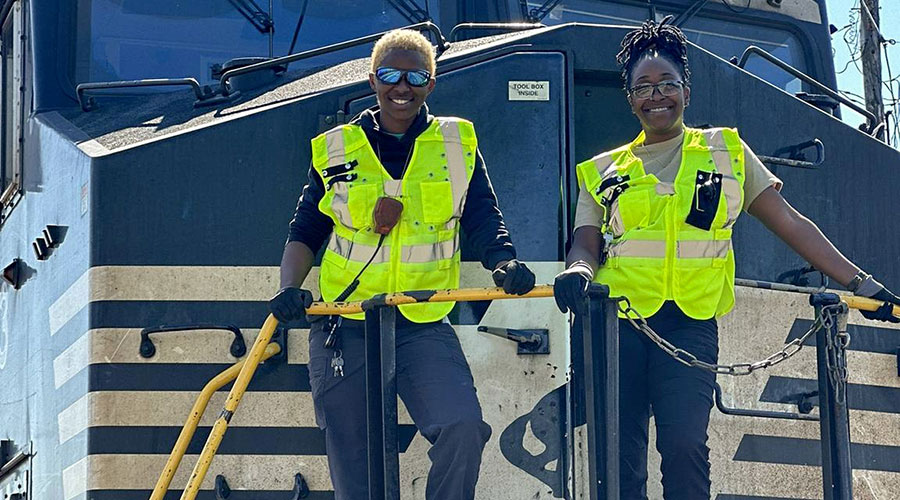Female train crew makes history in Columbia, S.C.
4/18/2024
By Julie Sneider, Senior Editor
When Courtney Thompson and Thara Hall were scheduled to work together for a week last month as a Norfolk Southern Railway train crew in Columbia, South Carolina, they had no idea their assignment would make history — or go viral on social media.
Thompson, 32, a train engineer, and Hall, 31, a train conductor, each had signed up for a week’s shift in Columbia. Although they knew of each other, they hadn’t worked together.
Thompson, who began her rail career when she joined NS as a conductor in 2017, received her engineer certification in early March; Hall joined NS as a new conductor about a year ago.
When they arrived for work on the first day of their scheduled week together, it was discovered they would be the first Black-female crew to operate an NS train in Columbia, South Carolina. Not only that, Thompson is the first Black woman to serve as an NS train engineer in Columbia.
“We went on at 6 that morning and to my surprise, when we came in everybody was like, ‘Oh, my goodness. We can’t believe we have both of y’all on the same job,’” says Thompson. “Everybody was really excited once we walked in, and the rest of the week was very eventful.”
To mark the historic occasion — which coincidentally occurred in March, which is Women’s History Month — someone from the NS communications team took Thompson and Hall’s photo together and posted it on the company’s internal network. Many NS employees saw the photo and liked it, so the team posted it on NS’ social media sites, says NS Senior Communications Manager Heather Garcia.
Social media mania
When the Thompson-Hall crew arrived at the first stop on their assignment, they were greeted with applause and praise, which came as a complete surprise to both, they said.
As the week wore on, their photo continued to be liked and shared; on Facebook, it received more than 6 million views, 138,000 likes, 17,000 shares and 10,000 comments, according to Garcia.
“That’s way more of a reaction than we normally receive,” says Garcia. “It was wild.”
Added Hall: “When they took that photo, I thought it was going to get a couple of ‘likes’ here and there. But it was trending for at least a week or two. And I was like, ‘Wow.’”
The reactions they received from other NS employees and comments on social media were positive and uplifting, Thompson and Hall say. So, too, were responses from strangers as their train traveled along its route. People in cars waiting at grade crossings waved enthusiastically.
“People we didn’t even know took pictures of us,” Hall says.
Thompson says she’s heard from women who’ve said they didn’t know females could become train engineers or conductors. She’s been responding to invitations from her church, schoolteachers and Girl Scout leaders to talk with young people about what it’s like to be a woman working for a railroad. Both she and Hall say they’re looking forward to spreading the word, especially among girls.
Thompson’s railroad career began by accident, she says. Her mother called one day to ask her to alert a cousin about an upcoming hiring session at NS. But the cousin was unable to go, so he asked Thompson to attend it for him and collect information about the job openings. At the time, Thompson worked in the psychiatric ward of a health care facility.
“It was my day off from work and I had nothing else going on,” she recalls. “People who attended the session were asked to fill out a job application, so I did.”
Two days later, when NS called her in for a job interview, Thompson decided to follow through with it.
“I’m a firm believer that everything happens for a reason,” she says, noting that out of hundreds of people at the informational session, only about five were female. “So, when they called me, I thought they called for a reason and that I would give this job a try.”
In researching the company, Thompson discovered railroading entailed lots of physical labor and working outdoors.
“I’ve always been a girly girl. I love to get my nails done,” she says. “I realized, ‘Oh, I’m going to have to cut my nails.’ I did trim them a little bit, but not much. And literally for seven years on the job, I have not broken a nail.”
And after completing the job training, she realized she didn’t mind working outdoors. Nor did the physical labor part of the job phase her: “I am a Zumba instructor,” she adds.
Serving as role models
Thompson’s message to other women and girls: Yes, females can become railroad conductors and engineers.
Hall agrees. She’s pleased to be viewed as a role model.
“I feel like we’re setting a good example or trend for others who want to join the railroad because, of course, it’s a male-dominated field,” she says. “Even though you don’t see a lot of females, it’s still a good job. We have to lace up our boots just like the men do.”
Hall’s entry into railroading followed other stints in the transportation sector: first at FedEx and then as a cargo dispatcher at Delta Air Lines. Her future career goals include becoming a train engineer and, possibly, a yard master, she says.
Asked what it’s like to know she and her colleague Thompson made railroad history, Hall said: “We’re going to keep climbing and being safe out there.”


